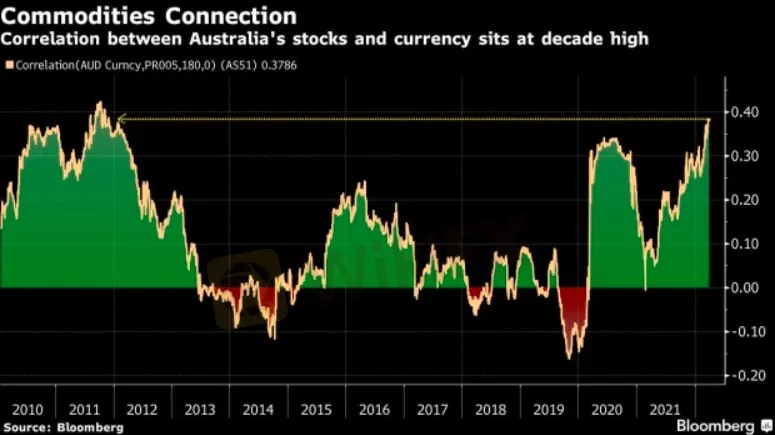简体中文
繁體中文
English
Pусский
日本語
ภาษาไทย
Tiếng Việt
Bahasa Indonesia
Español
हिन्दी
Filippiiniläinen
Français
Deutsch
Português
Türkçe
한국어
العربية
Commodities Boom Sends Aussie, Stocks Correlation to Decade-High
Abstract:Pedestrians are reflected in a window as they walk past an electronic stock board at the ASX Ltd. exchange centre in Sydney, Australia, on Thursday, Feb. 14, 2019.
The relationship between Australias equities and currency has become the closest in a decade as commodity prices surge.

The 180-day correlation between the country‘s stock benchmark and the Australian dollar has climbed to the highest level since late 2011, according to data compiled by Bloomberg. The strengthened ties come as rallies in materials from oil to iron ore have boosted both the nation’s equities and the Aussie.
Commodity-price movements stand out as a “common theme” in times of high correlation between the two assets, said Carl Capolingua, an analyst at ThinkMarkets Australia. The connection between Australias shares and currency “tends to be the highest during some pretty significant macroeconomic dislocation,” he said.
Energy and materials stocks are among the top gainers this year on the S&P/ASX 200 Index, with the former surging 28% and the latter rising 11%. The two sectors make up almost 30% of the broader gauge, their highest weighting since 2011, data compiled by Bloomberg show.
While miners have long been one of the largest components in Australia‘s stock market, their weighting has increased following the unification of BHP Group Ltd. The world’s biggest miner became the indexs largest stock after the company scrapped its dual-listing structure in January.
Australias dollar has strengthened about 3% this year to make it the best-performing Group-of-10 currency over the period. The Aussie, which traded at 74.79 U.S. cents Friday, has surged more than 7% since touching its lowest in more than a year in late January.
‘Remain Elevated’
“With supply constraints and the Russia-Ukraine war continuing, commodity prices will remain elevated,” potentially pushing the Australian dollar up to 80 cents in the next six months, said Russel Chesler, head of investments and capital markets at VanEck Associates Corp. in Sydney.
Surging commodity prices arent the only things propelling both assets. Bets on tighter monetary policy have boosted the Aussie and share prices of local banks, the largest sub-group on the stock benchmark.
Still, a strong currency hasn‘t always been a boon for the economy or the nation’s stocks. It can reduce the value of earnings from commodity exports, which are priced in U.S. dollars, and hurt profitability at tourism and education companies by raising the costs for foreign purchasers.
In addition, the S&P/ASX 200 Index dropped 15% in 2011, its worst year outside the global financial crisis in 2008, after the Australian dollar rose above $1.10 for the first time since it was freely floated in 1983.
Disclaimer:
The views in this article only represent the author's personal views, and do not constitute investment advice on this platform. This platform does not guarantee the accuracy, completeness and timeliness of the information in the article, and will not be liable for any loss caused by the use of or reliance on the information in the article.
Read more

How Inflation Rates Affect Forex Prices Globally
In this article, we’ll explore how inflation affects forex prices globally, the relationship between inflation and currency value, and why traders monitor inflation closely.

How to connect to VPS on Mac?
Mac连接VPS

How to connect to VPS in Windows?
Windows连接VPS

Prohibited Activities on VPS
VPS禁止行为
WikiFX Broker
Latest News
CySEC Warns Against Unauthorized Investment Firms in Cyprus
Why Even the Highly Educated Fall Victim to Investment Scams?
Warning Against Globalmarketsbull & Cryptclubmarket
Dukascopy Bank Expands Trading Account Base Currencies
UK Sets Stage for Stablecoin Regulation and Staking Exemption
Axi Bids AUD 52M to Acquire Low-Cost Broker SelfWealth, Outbidding Competitor Bell Financial
Crypto Influencer's Body Found Months After Kidnapping
STARTRADER Issues Alerts on Fake Sites and Unauthorized Apps
Italy’s CONSOB Blocks Seven Unregistered Financial Websites
Bitfinex Hacker Ilya Lichtenstein Sentenced to 5 Years in Prison
Currency Calculator


